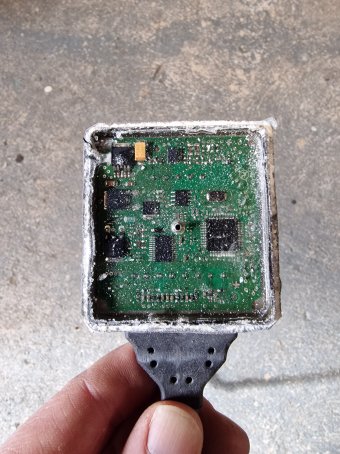Mat-One-T
Member
Hi Everyone,
I recently had an intermittent engine warning light on the dash (2017 V250 AMG), and took it to my local garage to read the fault code. The code came back as a NOx sensor fault (there are two sensors on the exhaust, but they couldn't tell me which one it was as they're not a MB dealer and don't have the full MB diagnostic system), and after reading up on the issue I decided that I would replace the sensors as the van has done ~50k miles.
I asked my local MB dealership to quote me for the sensors, and they're around £400 each at the time of writing. Generic sensors are available for around £115 each on ebay, so I took a chance and bought two. There are mixed reports about whether generics are worth the saving, as they potentially won't work, or will have a shorter life than genuine parts. I based my purchase on the reviews, link to the sensor below (might be specific to year/engine, so speak to MB dealership to get part number specific to your vehicle):
NOx sensor for Mercedes-Benz # A0009058411 A 000 905 84 11 | eBay
In the time it took me to get organised and buy the sensors my AdBlue system became unhappy as it couldn't get NOx values from the sensors, so didn't know how much AdBlue to inject into the exhaust, and threw out a code resulting in in an 'AdBlue System Malfunction' on the dash whenever the vehicle was unlocked/started. After a little more procrastination time the AdBlue warning progressed to a milage countdown (500 miles) before it would go into 'Emergency Mode'.
On my van the NOx sensors can be easily accessed from the drivers' side, I drove onto levelling chocks to raise it a bit and chocked the opposite side wheels to prevent any roll-back.
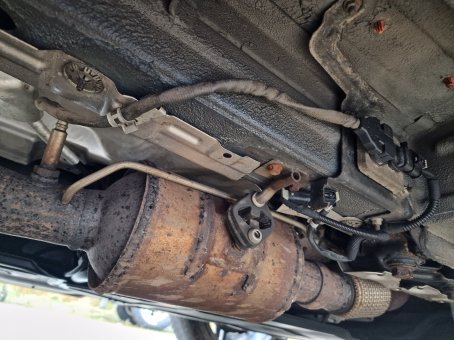
Front sensor threaded into the exhaust just behind the small bore pipe on the left.
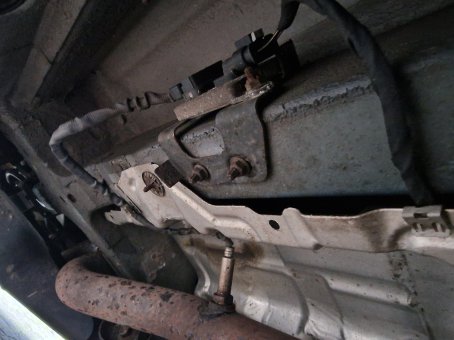
Rear sensor, bottom middle.
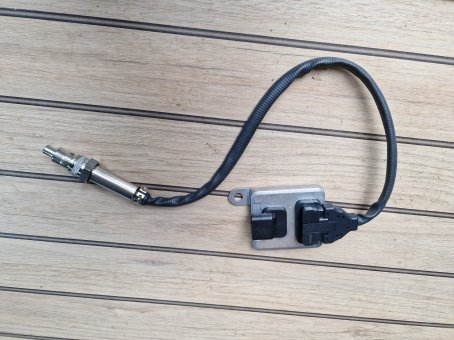
New sensor before fitting.
Disconnect the cable from the electronics module (there's a small grey sliding clip you need to lever up with a screwdriver), and unbolt the electronics module by removing the two nuts (10mm socket).
The front sensor was very hard to remove and I had to heat up the threaded plug with a blow lamp in order to remove it. The threads on the old sensor looked pretty damaged, so I bought a thread chasing tool from Amazon (there might be better ones than the one I bought, but it was on next-day delivery, so I went for it). I also purchased a NOx sensor removal tool (basically a 22mm socket with a cut-out so you can fit it over the sensor wire). Links below:
GEARZAAR Oxygen sensor socket NOX Sensor lambda Socket Removal Tool 22mm 3/8-Inch with Wide Side Cutout Fit for Most Vehicles and Trucks : Amazon.co.uk: DIY & Tools
Sealey Fuel Vaporiser Port Thread Chaser Ford M20 x 1.5mm - VS537 : Amazon.co.uk: Automotive
The rear sensor was much easier to remove, possibly due to less heat from the exhaust. I've since read that the ports in the sensors can become blocked and can be cleaned using brake cleaner, but I re-checked mine and they looked OK, so assuming there was actually something else wrong with them.
I also removed the AdBlue injector (near to the front NOx sensor) as I'd seen content on YouTube suggesting that the injector can become encrusted with urea crystals, and even the injection port blocked. There are a lot of scare stories online about needing to replace the AdBlue tank as it has pumps and heaters internally that can't be swapped out, and can run to £2-3k in parts/labour from a main dealer. I was hoping that this was not the case!
The injector is held in place by a clamp which has a star-shaped nut (like Torx) on it that none of my sockets would fit onto (and it was fairly inaccessible), so I ended up grinding through the clamp ring using a power file (the clamp is stainless, so couldn't cut through it with snips). New clamp from ebay (again, might be engine/year specific):
Adblue injector Clamp for Mercedes replaces A0009951133 | eBay
Thankfully the new clamp has an socket head allen key bolt, so is much easier to re-fit.
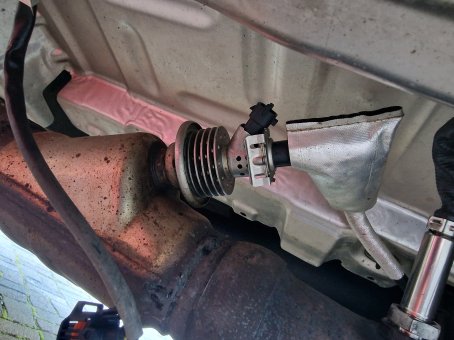
Ad-Blue injector, cable removed.
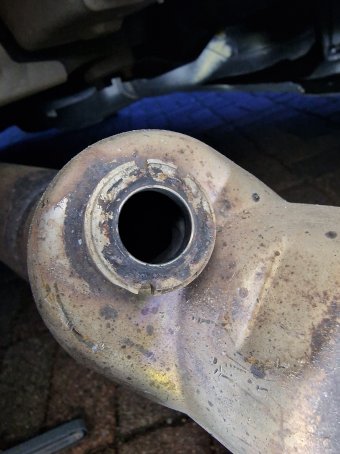
Ad-Blue injection port, no crystals/blockage.
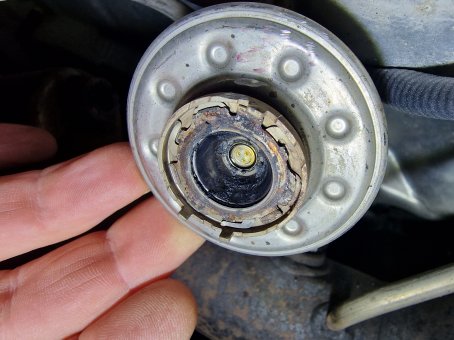
AdBlue injector underside (three small holes, which looked to be clear)
I re-fitted the AdBlue injector and eagerly jumped into the van to start it up and enjoy the extinguishing of dash warning lights and a happy AdBlue system. I was disappointed!
After a little more research I discovered that the codes need to be cleared using a diagnostic tool, so I ordered a Carly tool (Diagnose and code your car | Carly OBD (mycarly.com)). I went for the Carly as I'd heard good things, and there's a lot of support available (plus online guides for some repairs). It should be noted that Mercedes are not as accommodating as other car brands with respect to allowing third-party OBDII scanners to interrogate their systems. Some of the live data from my Carly scanner does not seem correct, or even populated, so I am not recommending this particular scanner. I'm going to speak to them and see why I don't get all the values they claim, and will update if anything comes back on the subject.
I installed the Carly app on my phone, connected the code scanner (dongle) to the OBDII port (which is tucked up under the dash to the right of the accelerator pedal (RHD model), will need a torch to find the cover and unclip it.
I ran a diagnostic (took around 5 minutes, engine running) and a reasonable number of codes were returned (bulb errors, rear window error etc), but the codes I needed were listed, which were for NOx sensor faults and AdBlue system malfunction and milage restriction.
I cleared the faults, turned off the van, locked it, unlocked it and the AdBlue milage limit was still showing on the dash, but the engine warning light had extinguished..!
I re-scanned the vehicle with the Carly app, and the AdBlue milage limit fault had re-appeared, so I cleared it again. And again. And again. The warning wouldn't stay cleared, so I contacted my local non-MB garage and asked them if they had a more advanced (expensive) diagnostic tool. They said that they'd had trouble with MB AdBlue systems before, and that they can be pretty hard to clear off, but would have a go.
I let the van sit for 4 days as I didn't want to use up my mile limit, and started it up to drive to the garage; no AdBlue warning. No idea why, but the AdBlue warning has cleared itself. The day after I cleared the codes I did a 30 mile trip, so it's possible that the system reset during the drive, but I'm none the wiser. Cancelled garage appointment, made a cup of coffee ..
Hopefully all will be good for the foreseeable future, but will update if anything changes.
I recently had an intermittent engine warning light on the dash (2017 V250 AMG), and took it to my local garage to read the fault code. The code came back as a NOx sensor fault (there are two sensors on the exhaust, but they couldn't tell me which one it was as they're not a MB dealer and don't have the full MB diagnostic system), and after reading up on the issue I decided that I would replace the sensors as the van has done ~50k miles.
I asked my local MB dealership to quote me for the sensors, and they're around £400 each at the time of writing. Generic sensors are available for around £115 each on ebay, so I took a chance and bought two. There are mixed reports about whether generics are worth the saving, as they potentially won't work, or will have a shorter life than genuine parts. I based my purchase on the reviews, link to the sensor below (might be specific to year/engine, so speak to MB dealership to get part number specific to your vehicle):
NOx sensor for Mercedes-Benz # A0009058411 A 000 905 84 11 | eBay
In the time it took me to get organised and buy the sensors my AdBlue system became unhappy as it couldn't get NOx values from the sensors, so didn't know how much AdBlue to inject into the exhaust, and threw out a code resulting in in an 'AdBlue System Malfunction' on the dash whenever the vehicle was unlocked/started. After a little more procrastination time the AdBlue warning progressed to a milage countdown (500 miles) before it would go into 'Emergency Mode'.
On my van the NOx sensors can be easily accessed from the drivers' side, I drove onto levelling chocks to raise it a bit and chocked the opposite side wheels to prevent any roll-back.

Front sensor threaded into the exhaust just behind the small bore pipe on the left.

Rear sensor, bottom middle.

New sensor before fitting.
Disconnect the cable from the electronics module (there's a small grey sliding clip you need to lever up with a screwdriver), and unbolt the electronics module by removing the two nuts (10mm socket).
The front sensor was very hard to remove and I had to heat up the threaded plug with a blow lamp in order to remove it. The threads on the old sensor looked pretty damaged, so I bought a thread chasing tool from Amazon (there might be better ones than the one I bought, but it was on next-day delivery, so I went for it). I also purchased a NOx sensor removal tool (basically a 22mm socket with a cut-out so you can fit it over the sensor wire). Links below:
GEARZAAR Oxygen sensor socket NOX Sensor lambda Socket Removal Tool 22mm 3/8-Inch with Wide Side Cutout Fit for Most Vehicles and Trucks : Amazon.co.uk: DIY & Tools
Sealey Fuel Vaporiser Port Thread Chaser Ford M20 x 1.5mm - VS537 : Amazon.co.uk: Automotive
The rear sensor was much easier to remove, possibly due to less heat from the exhaust. I've since read that the ports in the sensors can become blocked and can be cleaned using brake cleaner, but I re-checked mine and they looked OK, so assuming there was actually something else wrong with them.
I also removed the AdBlue injector (near to the front NOx sensor) as I'd seen content on YouTube suggesting that the injector can become encrusted with urea crystals, and even the injection port blocked. There are a lot of scare stories online about needing to replace the AdBlue tank as it has pumps and heaters internally that can't be swapped out, and can run to £2-3k in parts/labour from a main dealer. I was hoping that this was not the case!
The injector is held in place by a clamp which has a star-shaped nut (like Torx) on it that none of my sockets would fit onto (and it was fairly inaccessible), so I ended up grinding through the clamp ring using a power file (the clamp is stainless, so couldn't cut through it with snips). New clamp from ebay (again, might be engine/year specific):
Adblue injector Clamp for Mercedes replaces A0009951133 | eBay
Thankfully the new clamp has an socket head allen key bolt, so is much easier to re-fit.

Ad-Blue injector, cable removed.

Ad-Blue injection port, no crystals/blockage.

AdBlue injector underside (three small holes, which looked to be clear)
I re-fitted the AdBlue injector and eagerly jumped into the van to start it up and enjoy the extinguishing of dash warning lights and a happy AdBlue system. I was disappointed!
After a little more research I discovered that the codes need to be cleared using a diagnostic tool, so I ordered a Carly tool (Diagnose and code your car | Carly OBD (mycarly.com)). I went for the Carly as I'd heard good things, and there's a lot of support available (plus online guides for some repairs). It should be noted that Mercedes are not as accommodating as other car brands with respect to allowing third-party OBDII scanners to interrogate their systems. Some of the live data from my Carly scanner does not seem correct, or even populated, so I am not recommending this particular scanner. I'm going to speak to them and see why I don't get all the values they claim, and will update if anything comes back on the subject.
I installed the Carly app on my phone, connected the code scanner (dongle) to the OBDII port (which is tucked up under the dash to the right of the accelerator pedal (RHD model), will need a torch to find the cover and unclip it.
I ran a diagnostic (took around 5 minutes, engine running) and a reasonable number of codes were returned (bulb errors, rear window error etc), but the codes I needed were listed, which were for NOx sensor faults and AdBlue system malfunction and milage restriction.
I cleared the faults, turned off the van, locked it, unlocked it and the AdBlue milage limit was still showing on the dash, but the engine warning light had extinguished..!
I re-scanned the vehicle with the Carly app, and the AdBlue milage limit fault had re-appeared, so I cleared it again. And again. And again. The warning wouldn't stay cleared, so I contacted my local non-MB garage and asked them if they had a more advanced (expensive) diagnostic tool. They said that they'd had trouble with MB AdBlue systems before, and that they can be pretty hard to clear off, but would have a go.
I let the van sit for 4 days as I didn't want to use up my mile limit, and started it up to drive to the garage; no AdBlue warning. No idea why, but the AdBlue warning has cleared itself. The day after I cleared the codes I did a 30 mile trip, so it's possible that the system reset during the drive, but I'm none the wiser. Cancelled garage appointment, made a cup of coffee ..
Hopefully all will be good for the foreseeable future, but will update if anything changes.



